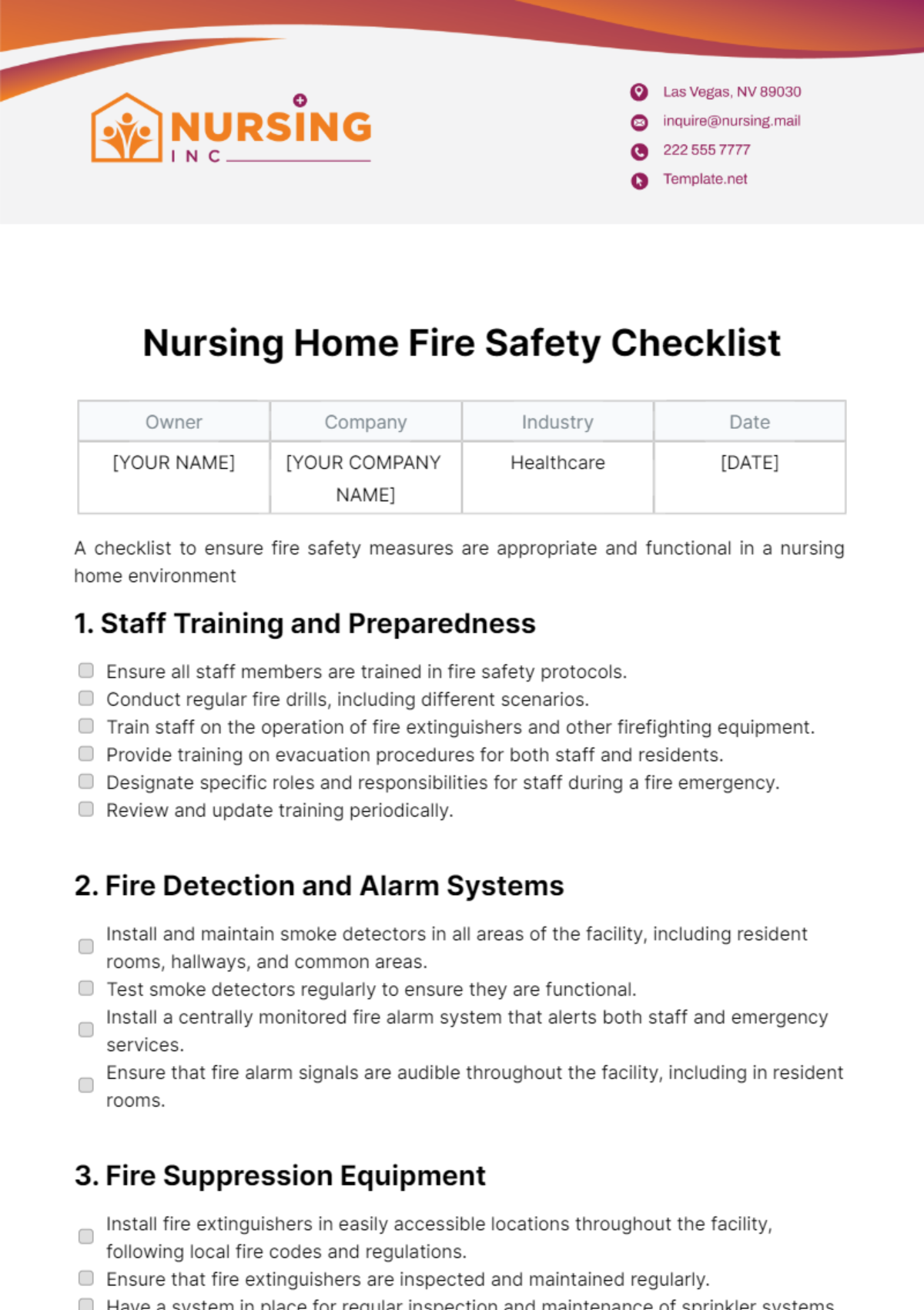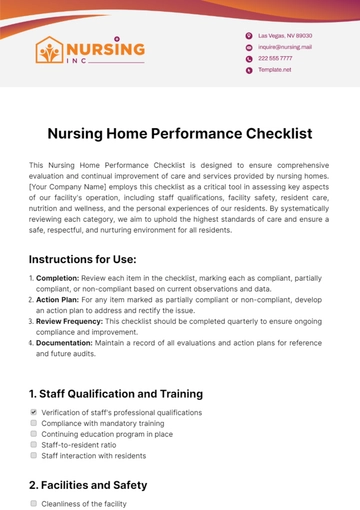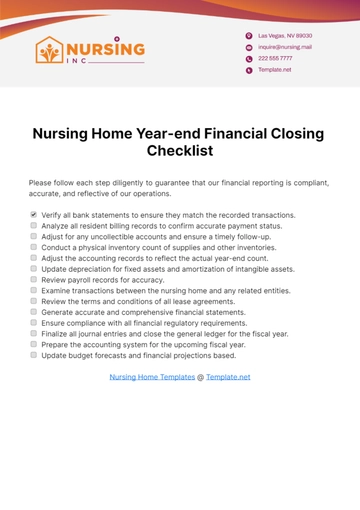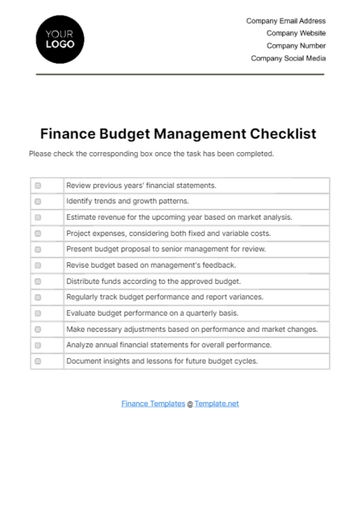Free Nursing Home Fire Safety Checklist

Owner | Company | Industry | Date |
|---|---|---|---|
[YOUR NAME] | [YOUR COMPANY NAME] | Healthcare | [DATE] |
A checklist to ensure fire safety measures are appropriate and functional in a nursing home environment
1. Staff Training and Preparedness
Ensure all staff members are trained in fire safety protocols.
Conduct regular fire drills, including different scenarios.
Train staff on the operation of fire extinguishers and other firefighting equipment.
Provide training on evacuation procedures for both staff and residents.
Designate specific roles and responsibilities for staff during a fire emergency.
Review and update training periodically.
2. Fire Detection and Alarm Systems
Install and maintain smoke detectors in all areas of the facility, including resident rooms, hallways, and common areas.
Test smoke detectors regularly to ensure they are functional.
Install a centrally monitored fire alarm system that alerts both staff and emergency services.
Ensure that fire alarm signals are audible throughout the facility, including in resident rooms.
3. Fire Suppression Equipment
Install fire extinguishers in easily accessible locations throughout the facility, following local fire codes and regulations.
Ensure that fire extinguishers are inspected and maintained regularly.
Have a system in place for regular inspection and maintenance of sprinkler systems.
4. Building Construction and Maintenance
Regularly inspect the building for fire hazards, such as blocked exits, damaged electrical wiring, or storage of flammable materials.
Keep exits and escape routes clear of obstructions at all times.
Maintain fire-resistant doors and windows to prevent the spread of fire.
Ensure that the building's electrical system is up to code and inspected regularly.
5. Emergency Evacuation Plan
Develop a detailed evacuation plan tailored to the layout of the facility.
Assign staff members to assist residents with mobility issues during evacuation.
Establish designated assembly areas outside the building where residents and staff will gather after evacuation.
Practice the evacuation plan regularly, including scenarios involving residents with various mobility levels.
Have a plan in place for relocating residents to a safe location in case of an extended evacuation.
6. Resident Education and Communication
Educate residents about fire safety procedures and the importance of reacting quickly in case of a fire.
Provide information to residents on how to respond to fire alarms and evacuate safely.
Ensure that residents know the location of fire extinguishers and emergency exits.
Communicate any changes or updates to fire safety procedures to residents and their families.
7. Collaboration with Emergency Services
Establish a protocol for communication and coordination with local fire departments and emergency responders.
Provide emergency responders with access to building plans and other relevant information to facilitate a swift response in case of a fire.
Conduct joint training exercises with emergency services to familiarize them with the layout of the facility and evacuation procedures.
8. Regular Review and Improvement
Conduct regular reviews of the facility's fire safety procedures and protocols.
Solicit feedback from staff, residents, and families on areas for improvement.
Update the fire safety plan as needed based on feedback, changes in regulations, or lessons learned from drills or real-life incidents.
- 100% Customizable, free editor
- Access 1 Million+ Templates, photo’s & graphics
- Download or share as a template
- Click and replace photos, graphics, text, backgrounds
- Resize, crop, AI write & more
- Access advanced editor
Prioritize safety with the Nursing Home Fire Safety Checklist Template from Template.net. Editable and customizable, it streamlines the process of inspecting fire safety measures and protocols in nursing home facilities. Tailor it effortlessly using our Ai Editor Tool for personalized checklists. Enhance fire safety preparedness and protect residents and staff with this essential template.
You may also like
- Cleaning Checklist
- Daily Checklist
- Travel Checklist
- Self Care Checklist
- Risk Assessment Checklist
- Onboarding Checklist
- Quality Checklist
- Compliance Checklist
- Audit Checklist
- Registry Checklist
- HR Checklist
- Restaurant Checklist
- Checklist Layout
- Creative Checklist
- Sales Checklist
- Construction Checklist
- Task Checklist
- Professional Checklist
- Hotel Checklist
- Employee Checklist
- Moving Checklist
- Marketing Checklist
- Accounting Checklist
- Camping Checklist
- Packing Checklist
- Real Estate Checklist
- Cleaning Checklist Service
- New Employee Checklist
- Food Checklist
- Home Inspection Checklist
- Advertising Checklist
- Event Checklist
- SEO Checklist
- Assessment Checklist
- Inspection Checklist
- Baby Registry Checklist
- Induction Checklist
- Employee Training Checklist
- Medical Checklist
- Safety Checklist
- Site Checklist
- Job Checklist
- Service Checklist
- Nanny Checklist
- Building Checklist
- Work Checklist
- Office Checklist
- Training Checklist
- Website Checklist
- IT and Software Checklist
- Performance Checklist
- Project Checklist
- Startup Checklist
- Education Checklist
- Home Checklist
- School Checklist
- Maintenance Checklist
- Planning Checklist
- Manager Checklist
- Wedding Checklist
- Vehicle Checklist
- Travel Agency Checklist
- Vehicle Inspection Checklist
- Interior Design Checklist
- Backpacking Checklist
- Business Checklist
- Legal Checklist
- Nursing Home Checklist
- Weekly Checklist
- Recruitment Checklist
- Salon Checklist
- Baby Checklist
- Equipment Checklist
- Trade Show Checklist
- Party Checklist
- Hospital Bag Checklist
- Evaluation Checklist
- Agency Checklist
- First Apartment Checklist
- Hiring Checklist
- Opening Checklist
- Small Business Checklist
- Rental Checklist
- College Dorm Checklist
- New Puppy Checklist
- University Checklist
- Building Maintenance Checklist
- Work From Home Checklist
- Student Checklist
- Application Checklist





























